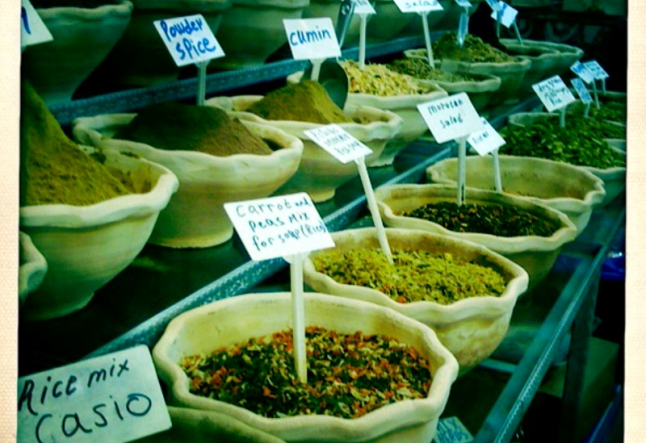indian kitchen

Indian Kitchen | Indian Spices | Indian Food
I love Indian cuisine: the curries, spices, tandoori, teas, yogurt drinks and that delicious naan bread! Delicacies of culinary India are extremely popular in western countries, but how much do we know about Indian cuisine and the herbs and spices used? Spices such as garlic, onions, ginger, cilantro, cumin and turmeric have been a stable in Indian cuisine for thousands of years to add rich flavor to the foods. Because most Indian dishes found in local restaurants are usually cooked and not raw, the therapeutic properties are diminished. However, some positive aspects of those properties remain. I am uncertain whether the spiritual practice of Ayurveda strongly influenced the origins of Indian cuisine. The unquestionable warmth and patience recognized in Indian culture and cooking is felt in the blessed palettes of all who partake in her culinary delights!
I worked in an Indian restaurant for 2 years while putting myself through college in my home town in Australia. As I set up for the evening meal, I would savor the smell of the kitchen and appreciate the arduous preparation required by most dishes. Many dishes are marinated for at least 4 hours in homemade yogurt and fresh picked herbs, commonly mint and cilantro. A good restaurant will make yogurt and cheese on the premises.
I am told that the food in India differs some from the style that has been modified to suite the western palette, i.e. thick creamy sauces and more subtle flavors. Still, there remains a strong aunthentic identity within the kitchen. The Tandoori oven is unique and extremely versatile. Averaging around 3 feet tall, it is concrete with a fire in the middle and a round opening at the top. It looks more like a kiln for making pottery than an oven. It is used to make breads and to slowly bake other main dishes, especially brightly colored tandoori or tikka. The naan and roti breads are cooked on the inside of the oven wall adhered by a few droplets of water on the surface of the dough.
Ghee is used as oil in Indian cooking and spread on Naan bread. Ghee is clarified butter that has the milk solids and water removed. The removed milk solids contain the protein beta lacta globulin and casein responsible for most allergies to milk. According to Ayurveda, ghee is the best oil for cooking because when used in moderation it stimulates digestion and is more readily metabolized than margarine or regular cooking oils. Some dishes are rich in protein and fiber such as dahl (legumes and pulses in many variations), channa (garbanzo beans) and sag paneer, a delicious combination of spinach and homemade cheese sautéed in ghee, garlic and spices. The homemade cheese is similar in texture to feta and is referred to as ”˜paneer.’ Others dishes are heavier and high in saturated fat, which may leave you feeling bloated and uncomfortable, such as the tikka masala dishes, which are full of butter and heavy cream.
A heavenly dish laden with garlic is eggplant bhorta (I have found the name differs from restaurant to restaurant). It is made with sautéed eggplant in herbs and spices, least of which is garlic! Garlic is commonly used in curries and just about all matter of Indian preparations. Garlic contains sulfur compounds and other phytochemicals which work together to encourage a healthy intestinal environment and proper gastrointestinal flora.
Another staple of Indian dining is rice. Saffron is often mixed with rice to give it a bright yellow/orange color, delicious aroma and mild bitter flavor. Cilantro, ginger and nutmeg are also often added to rice for flavor and aroma and have additional health benefits. Ginger contains an essential oil and other compounds which help ease the effects of an upset stomach. Ginger and cilantro can also help cleanse the colon, promote healthy digestion and help maintain normal body temperature. The strong aromas that come from Indian foods have their own therapeutic action. Your nose sends a message to the digestive system that food is on its way, stimulating enzyme production to promote healthier digestion and a more efficient metabolism.
In some restaurants a small dish of spices is often on the table or near the exit containing cinnamon, nutmeg, cloves and others. Many people are unaware that these spices are edible and cleanse the breath and encourage optimum digestive health. The clove is a potent and delicious spice. Around the world clove is chewed for its antiseptic, sedative and analgesic (pain relieving) properties. After a meal it encourages a sense of well being and relaxation as well as cleaning the teeth and gums. Cinnamon quills, a delicate and romantic spice also used in chai tea, assist the digestive system and leaves your breath smelling sweet.
So next time you have Indian food, I encourage you to try the lighter tomato-based curries and sauces. Spend a minute before eating to soak in the aroma of herbs and stimulate healthy digestive function. After the meal try the assortment of offered spices to clean the palette, refresh the breath and support your digestion. Enjoy the living light of foods and relish your healthy yoga body!
Read next >> superfood standouts